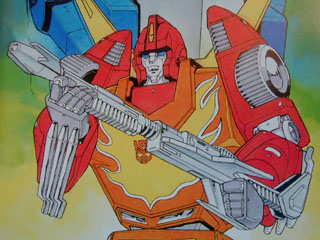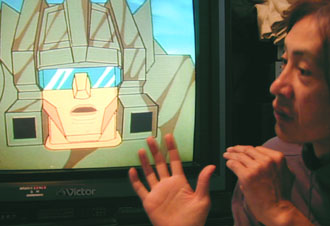Japan's Animators: On the Cutting Room Floor?
Because of the workman-like manner in which he taps out his stories, many often see the Captain as being blue-collar to the teeth. The Captain himself would of course agree with this assessment of his careful and studious approach, but at the same time, he'd add - in a lighter, perhaps joking, moment - that his collar can be any of red, white, or blue after a visit to the Yankee Doodle hostess club in Tokyo's Kabukicho district.
 In seeking out other like-minded spirits, this week he peeks inside Japan's massive animation industry to profile the work of its grunts - the animators themselves. Join him as he paints a picture of what life entails when wages are drawn with pencil in hand.
In seeking out other like-minded spirits, this week he peeks inside Japan's massive animation industry to profile the work of its grunts - the animators themselves. Join him as he paints a picture of what life entails when wages are drawn with pencil in hand.
It would be logical to think that Japan's legions of animators would be basking in great glory ever since this year's crowning of Hayao Miyazaki's Spirited Away, Japan's highest grossing film in history, as Best Animation Feature Film at the Academy Awards.
After all, recognition on the world's largest stage for film achievement - for many, the sure sign of success - reinforces Japan's continued domination of the genre. And indeed, this further is a barometer of the worldwide penetration of Japanese animation, or anime.
But the animators who toil at the industry's drawing boards are increasingly finding this profession to be a difficult one with veterans growing weary. "It's getting tougher and tougher," says Joji Oshima, a veteran animator of the green goo-spewing series The Teenage Mutant Ninja Turtles and the ever-changing robots featured in Transformers.
Truth be told, these are not the best of times to be making a living in Japan by filling in cels (still frames) with colored pencils. Potential obsolescence brought on by computer advances and overseas competition are leaving a lot of Japan's drawing wizards wondering if their future lies on the big screen or the cutting room floor.
 An animator might be seen as something similar to animation's version of the prop man or special effects technician in Hollywood motion pictures; he works in the background (quite literally), completing his work under the guidance of the creators of the characters and the producers of the features. But even given this, his role is as vital as Schwarzenegger's stunts are to one of his blockbusters. In short, the results of his craft are often a viewer's lasting image.
An animator might be seen as something similar to animation's version of the prop man or special effects technician in Hollywood motion pictures; he works in the background (quite literally), completing his work under the guidance of the creators of the characters and the producers of the features. But even given this, his role is as vital as Schwarzenegger's stunts are to one of his blockbusters. In short, the results of his craft are often a viewer's lasting image.
Since it can almost never be a position of great recognition, an animator enters the anime field because of a love of drawing - a dream of adding dashes of hundreds of colors and lines for storylines that unfold in surreal settings of fantasy. For Oshima, that was his reason for entering the animation fray 28 years ago.
In his home in a suburb just outside Tokyo, the angular and long-haired Oshima, 54, points at his TV screen showing a 15-year old episode from Transformers - a series set in a future world of non-stop robot battles.
The action is filled with slight pauses and staccato motions of the characters, or kime, a standard practice in anime. This is generally a Japanese innovation, and is dissimilar from the nearly life-like three-dimensional fantasies concocted by Pixar Animation of the U.S.
 "The quality is high," Oshima says of Pixar, "but if you think of Fantasia or Snow White and the Seven Dwarfs - the classics, they are fantastic, and done by hand. The feeling is totally different."
"The quality is high," Oshima says of Pixar, "but if you think of Fantasia or Snow White and the Seven Dwarfs - the classics, they are fantastic, and done by hand. The feeling is totally different."
The reason for the difference in feeling, however, is completely intentional, he says. "Disney production shows off that they use computer graphics. It is man-made and artificial. But that is the point."
And is the result of having more money to play with.
Even though the overall world market is dominated by Japan - sixty percent of the world's animated programs are from Japan with total sales doubling in the last 10 years to ¥186 billion yen - budgets for Hollywood animation movies can exceed ¥12 billion while Japanese anime projects are lucky if they can put together one-tenth that.
This wherewithal might allow 20 or 30 people to work on a Hollywood film for one week to produce 3 or 4 seconds of footage. But for projects Oshima has worked on as a freelancer, which he has been for Toei Animation and Sunrise Animation, it would require much more output using the same time and manpower. "For Transformers, we'd have to get a full hour," he laughs.
In addition to giving anime its character, kime helps fill this financial gap; it is a means of cutting corners without sacrificing quality - at least not too much. A typical Pixar film, Finding Nemo, for instance, might run through roughly 20,000 still images in 30 minutes, Oshima says. In that same time, one of his projects might use 3,000 to 5,000 images. The result is the relatively "jumpy" motions of the characters. To compensate, an anime feature will emphasize quality in those fewer images.
Upping the quality has become easier with the use of computer graphics. Main images, or "keyframes," are drawn by hand and scanned into a computer. Then generic features, which repeat frequently, for example, backgrounds, ground patterns, and clouds in the sky, are filled in with software. But such details within a keyframe, like the subtleties of expressions of a character's emotions or the actions of a robot's hands to raise a pistol are still almost entirely entrusted to the trusty eye (and pencil) of the lead animator. This blend of hand drawing with computer enhancement is what even the big studios like Pixar use for their projects.
 Toei Animation was one of the first to convert its operation in Japan when it started using a digital ink and painting system 7 years ago. (Though Miyazaki said after the Academy Awards that he instructed his animators not to rely on computers solely, his legendary Studio Glibi is rumored to have purchased computer software especially for the making of Spirited Away.)
Toei Animation was one of the first to convert its operation in Japan when it started using a digital ink and painting system 7 years ago. (Though Miyazaki said after the Academy Awards that he instructed his animators not to rely on computers solely, his legendary Studio Glibi is rumored to have purchased computer software especially for the making of Spirited Away.)
For Oshima, who does all his work by hand, computer advances are not good news. He still has value in this business because, as a lead animator for many projects, he gets jobs drawing main frames.
But being pushed aside by a computer is not his only worry: more and more of the mundane background work is being shipped overseas to such countries as China, Korea, and the Philippines, where labor is much cheaper than Japan. Though this has been going on for decades, an increased ease of transferring data through computer systems is making this a more viable option. And this isn't true just for television shows on tight budgets. Spirited Away employed Korean hands for certain parts of its production.
While this technological advancement and cost cutting might be a boon for the studios, it could also make for a cloudy future for young, up-and-coming Japanese artists. In days gone past, this grunt work - the fill-in work - was typically used for training purposes.
"You have to do the cheap work first to be an animator," Oshima maintains, noting that approximately seventy percent of such work is now in the hands of foreigners. "Soon it won't be Japanese animation - it'll be Asian animation."
Oshima remains undaunted. He just loves to draw.
His personal stake in computer advancements aside, Oshima still feels that a bit of the fantasy is missing when the digital applications of a mouse replace the meticulous analog strokes of a pencil. "The soul is lost," he says. "Now the film makers are just chasing the money, not the art."
Note: A special thanks goes to Toshio Maeda for assisting in this report.

